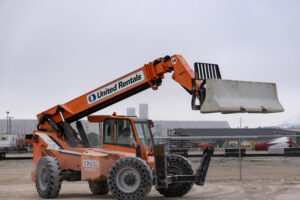In today’s world, every decision we make, even in infrastructure and construction, can have a significant impact. One area where this consideration is increasingly apparent is in the choice of traffic barriers. Traditionally, concrete and plastic barriers have been the go-to options, but now, there’s a rising trend towards eco-friendly alternatives that offer numerous advantages. Here are our thoughts on where to find these barriers, their applications, and why many people choose them in place of traditional concrete barriers.
Where to Find Eco-Friendly Traffic Barriers
When searching for eco-friendly traffic barriers, it’s essential to look for reputable suppliers that are invested in making them just as safe as their concrete counterparts. Our favorite supplier is Pretred, which makes its barriers out of recycled tires. Each barrier is made with 95% recycled materials and has lower ongoing maintenance needs (they won’t chip or crack like concrete). Here at 48 Barriers, we sell Pretred’s recycled rubber barriers at a competitive cost. We always want to give consumers the option to select barriers designed to minimize environmental impact during production and disposal.
Can I Use Rubber Barriers Just Like Concrete Barriers?
Eco-friendly traffic barriers serve the same fundamental purpose as their conventional counterparts: to manage and control traffic flow while ensuring safety for pedestrians and vehicles alike. These barriers find applications in various settings, including:
Road Construction Sites: Eco-friendly barriers provide temporary or permanent delineation and protection on road construction sites, ensuring the safety of workers and motorists.
Events and Festivals: They are often utilized to manage crowds and create safe zones during events, concerts, and festivals.
Parking Lots and Facilities: In parking lots and facilities, these barriers help organize traffic flow, designate parking areas, and enhance pedestrian safety.
Industrial and Commercial Zones: Eco-friendly barriers are valuable in industrial and commercial zones for segregating traffic, protecting infrastructure, and enhancing overall safety.
Advantages Over Concrete and Plastic Barriers:
Not surprisingly, eco-friendly traffic barriers offer several advantages over traditional concrete and plastic options:
Environmental Sustainability: Perhaps the most significant advantage is their reduced environmental impact. Many rubber barriers are made from recycled materials or are fully recyclable, minimizing resource consumption and waste generation. Plus, Pretred barriers produce 283% less carbon than concrete.
Reduced Carbon Footprint: Manufacturing processes for these barriers typically produce fewer greenhouse gas emissions compared to concrete or plastic alternatives, contributing to lower carbon footprints.
Cost Savings: These barriers can be installed and relocated with forklift slots, reducing overall costs as they can easily be transported to the next project.
Long-Lasting Performance: Despite being environmentally friendly, these barriers maintain longevity comparable to concrete and plastic options. They can withstand heavy rain, UV exposure, and traffic without compromising performance.
Aesthetic Appeal: These barriers can be enhanced using low cost “barrier jackets” in various colors to improve visibility or customization. They can also be custom printed to include company logos and various signage.
When to Choose Concrete Over Rubber Barriers
While rubber barriers are usually just as effective as concrete, there are a few reasons people may choose the traditional concrete route. Here are some reasons to consider concrete instead of rubber barriers:
Proven Track Record: Concrete barriers have been widely used in traffic management and safety applications for decades, demonstrating a proven track record of effectiveness and reliability in various scenarios.
Stability in Extreme Conditions: While rubber barriers are pretty tough, concrete barriers excel in withstanding harsh weather conditions like strong winds, rain, and snowstorms. Their weight and stability make them less susceptible to damage during severe weather events.
High Security: While a rubber barrier is about 1500 pounds, concrete barriers average 4,000 pounds each. Due to their heavy weight and solid construction, concrete barriers are often perceived as offering superior security compared to rubber barriers. They can deter unauthorized access and protect property against intrusion.
Permanent Installation: Concrete barriers are often chosen for applications where a more permanent solution is required. Once installed, they require minimal maintenance and offer long-term reliability, making them suitable for high-traffic areas and construction sites.
Concrete barriers might be a better option if you’ll be using them in an area prone to extreme weather or if your project is permanent. If you choose to opt for rubber traffic barriers, you’ll benefit from both an environmentally friendly choice and the numerous benefits rubber barriers offer. From their sustainable manufacturing processes to their versatile applications and long-term durability, these barriers are a great environmentally friendly choice. So, the next time you’re in need of traffic barriers, consider the eco-friendly option!
Contact us today via phone or email, or fill out a quick quote to get a cost estimate for rubber traffic barriers.




